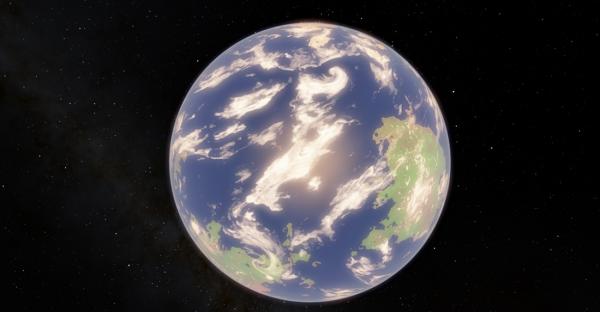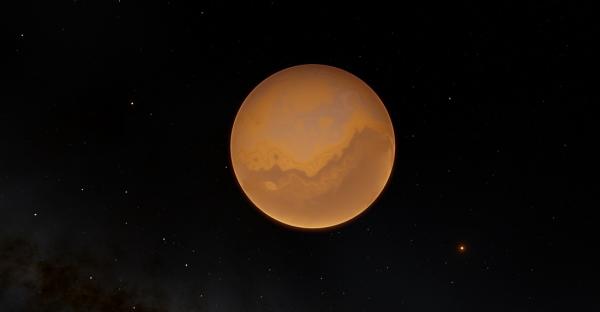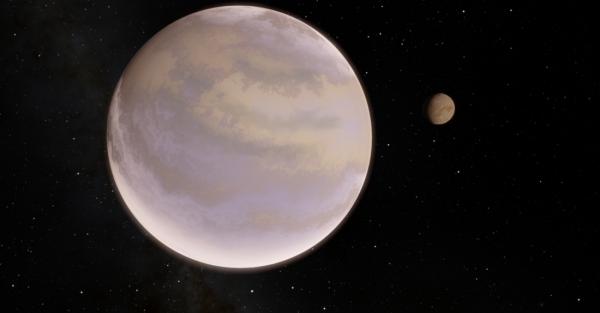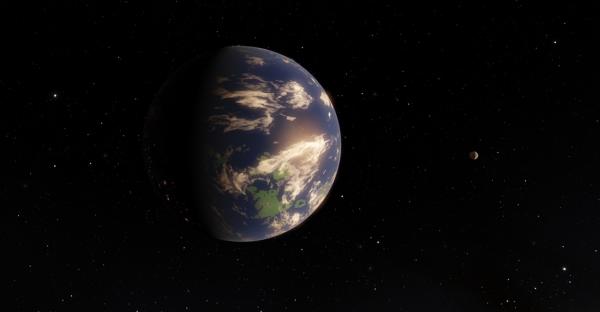BY LETTER
Regulus
Galactography > Regions of Space > Inner Sphere
Galactography > Civilized Galaxy - Sephirotic Empires > Sophic League
Galactography > Systems and Worlds > Systems & Worlds Q - R
A bright multiple star system with an extinct biosphere discovered on one planet, also site of early star-lifting experiments. Galactography > Civilized Galaxy - Sephirotic Empires > Sophic League
Galactography > Systems and Worlds > Systems & Worlds Q - R
Regulus -data panel | |
| Star Names | Regulus, α Leonis, 32 Leonis, Cor Leonis, Lion's Heart, Kalb al Asad, HIP49669 |
|---|---|
| Distance from Sol | 79 light years |
| RA | 10h 08m 12.8 |
| Dec | 11. 59′ 48 |
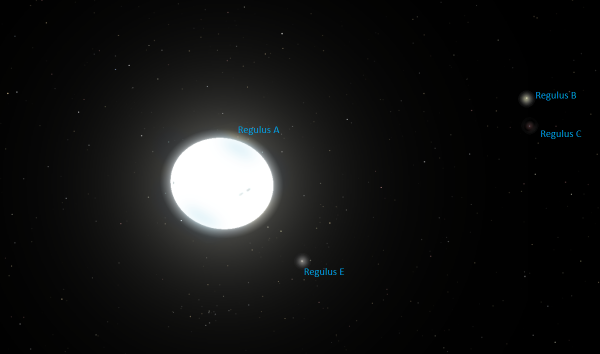 Image from Steve Bowers | |
| The four stars of the Regulus system as they existed when the colonists first arrived. Regulus A is rotating rapidly, and was one of the first stars to be modified by starlifting technology. | |
Quadruple star system | |
| Stars | Regulus A: oblate B8 blue-white subgiant Mass x 3.8 Sol Luminosity 300 x Sol (150 x Sol in visible light) Currently undergoing starlifting. Regulus E white dwarf orbiting Regulus A at 0.35 AU (this star lost a lot of mass to Regulus A during the last stages of its evolution) Regulus B K2V orange dwarf orbiting Regulus A at 4200 AU Mass 0.8 x Sol Luminosity 0.5 x Sol Regulus C M4V red dwarf in a binary pair with Regulus B, with a separation of 97 AU. Mass 0.3 x Sol Luminosity 0.02 x Sol |
|---|---|
Planets | |
| Planets orbiting Regulus A | 10084+1158a (Metasoft designation; this planet was originally given the name Dumuzid) Type Areanxeric (a desert world, formerly a Venus-like planet before Regulus E boiled most of its atmosphere away during its red giant phase) Diameter 12101km Mass 0.94 x Earth Surface gravity 0.99 x Earth Semi-major axis 3.81 AU Orbital period 3.81 standard years - 10084+1158b (Metasoft designation; this planet was originally given the name Ninlil) Type Ferrinian Type (a small, iron-rich world) Diameter 5137 km Mass 0.059 x Earth Surface gravity 0.36 x Earth Semi-major axis 6.08 AU Orbital period 7.69 standard years - The Lion's Mane, an asteroid belt between 7 and 15 AU - 10084+1158c (Metasoft designation; this planet was originally given the name Adapa) Type Selenian (a small dry world) Diameter 4085 km Mass 0.028 x Earth Surface gravity 0.27 x Earth Semi-major axis 26.3 AU Orbital period 69 standard years - 10084+1158d (Metasoft designation; this planet was originally given the name Uanna) Type EuJovian Type (a gas giant in 5/4 harmonic resonance with 10084+1158d) Diameter 120850 km Mass 129.7 x Earth Semi-major axis 30.6 AU Orbital period 86 standard years - 10084+1158e (Metasoft designation; this planet was originally given the name Neti) Type Skolian/Ikarian (a gas giant with an extreme axial tilt and high eccentricity) Diameter 101090 km Mass 80.9 x Earth Semi-major axis 106.84 AU Eccentricity 0.518 Periastron 51.45 AU Orbital period 566 standard years |
|---|---|
| Planets orbiting Regulus B | Nanshe: Type SuperCytherian (a super-Venus type world) Diameter 19376 km Mass 4.22 x Earth Surface Gravity 1.84 x Earth Semi-major axis 0.13 AU Orbital period 0.052 standard years - Ishtar: Type Gaian (a hot Earth-like type world, now terraformed) Diameter 11010 km Mass 0.68 x Earth Surface Gravity 0.92 x Earth Semi-major axis 0.13 AU Orbital period 0.27 standard years Moons 2; Nanna 630 km in diameter Suen 2480 km in diameter - Anu: Type MicroJovian Type (a small gas giant) Diameter 27010 km Mass 11.8 x Earth Semi-major axis 1.87 AU Orbital period 2.85 standard years - Kuiper belt between 3 AU and 30 AU, near the limit of stable orbits around this star |
| Planets orbiting Regulus C | Nabu: Type Hermian (a Mercury-like world) Diameter 5536 km Mass 0.073 x Earth Surface Gravity 0.39 x Earth Semi-major axis 0.0147 AU Orbital period 0.0032 standard years - Nergal: Type SubJovian Type (a small gas giant) Diameter 30009 km Mass 27.4 x Earth Semi-major axis 0.032 AU Orbital period 0.0104 standard years - Enlil: Type Arean (a Mars-like world, with evidence of an extinct biosphere. This world has a 2:3 spin-orbit resonance) Diameter 7190 km Mass 0.16 x Earth Surface Gravity 0.5 x Earth Semi-major axis 0.073 AU Orbital period 0.036 standard years - Ninurta: Type MicroJovian Type (a small ringed gas giant) Diameter 29190 km Mass 19.1 x Earth Semi-major axis 0.22 AU Orbital period 0.188 standard years - Enki: Type EuJovian Type. Diameter 140990 km Mass 434.2 x Earth Semi-major axis 0.91 AU Orbital period 1.58 standard years Kuiper belt between 1.4 AU and 20 AU, near the limit of stable orbits around this star |
Each pair of stars was colonized by different group. The primary pair was colonized by vecs (from 39 Leonis) in 2231 AT. The orange dwarf of the outer pair was colonized by a coalition of lazurogened members of the Homo genus, including Erectus, Heidelbergensis, and Neanderthals (from Xi Ursae Majoris) a few years later. The fleets detected each other and were in communication en route. The humans and vecs have had mostly neutral relations over the millennia, but a few minor conflicts and even full-scale wars have occurred on occasion.
The humans settled on Ishtar, the second planet of the orange dwarf which was a good terraformation candidate. They also occupied the moons of Anu, its Microjovian third planet.
An extinct biosphere is discovered
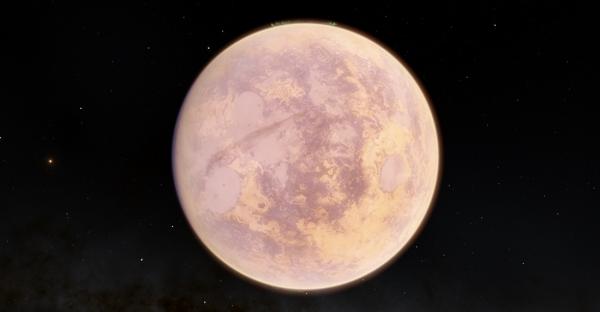 Image from person43 | |
| Enlil is a Arean world with xenofossils that indicate the former presence of a now-extinct biosphere | |
The apparent cause of the biosphere's collapse was the planet's small mass which allowed the atmosphere to slowly leak away, and then at least one major flare from the planet's sun which magnified the damage.
Terraformation of Ishtar
In 2372 the terraformation of Ishtar began, which would be completed 385 years later. In the modern era the planet's surface is divided into low-tech reserves, modern settlements that are inhabited only by the archaic humans, and cosmopolitan settlements inhabited by beings from the rest of the Terragen Sphere.Starlifting of Regulus A
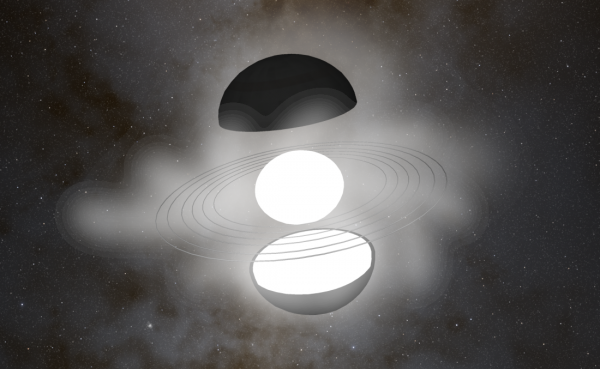 Image from Steve Bowers | |
| The star-lifting rig around Regulus A is powered by statite power collection caps supported by light pressure over the north and south poles; these collectors send energy to the equatorial rings, which scoop mass from the mid-regions and magnetically accelerate it into orbit | |
During the Version War the vecs in this system were nominally aligned with the Metasoft side, but they avoided the conflict by adopting an tacit stance of neutrality.
The starlifting operations continued unchecked during this period, and continued until the 6200s, removing a total of 0.4 solar masses from the star. At this point a archailect aligned with the Sophic League took control of the structure. The starlifting op has continued, but more intermittently and at a much lower rate.
The hominid cultures on Ishtar are also aligned with the Sophic League, and the local archailect is known to take a close interest in the welfare of these cultures. Some of the local cultures on this world utilise a typical technology level for Sephirotic modosophont-level cultures, while others are at Lotech or Prim level. Some of the largest and most sophisticated cities on this world have been designed and built by the Neanderthals, who have developed their own idiosyncratic forms of literature, music, architecture and art that are significantly different to those developed by Homo sapiens and their descendants.
Related Articles
Appears in Topics
Development Notes
Text by person43
additional material by Steve Bowers
Initially published on 06 June 2019.
additional material by Steve Bowers
Initially published on 06 June 2019.
